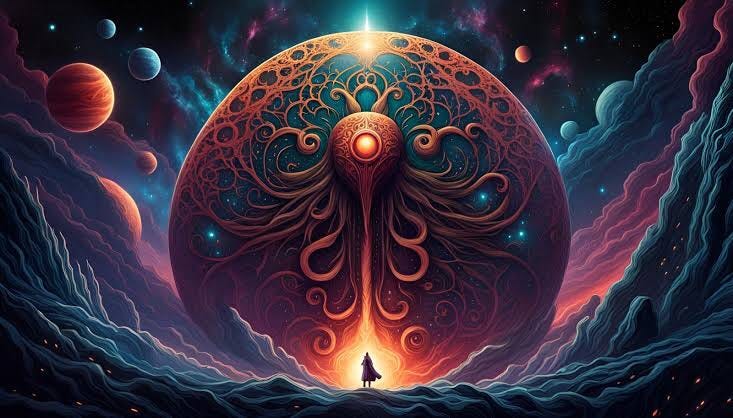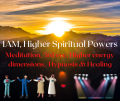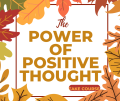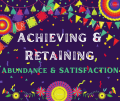
There are sacred times in life when we are called not just to reflect—but to incubate. Times when the activity of the soul becomes more potent than the noise of the world. These are not moments for performing, producing, or even preaching. These are moments for deep listening—to the whisper of Spirit, to the visions forming on the edge of consciousness, to the future speaking in symbols only the heart can translate.
I find myself in such a time now.

As I prepare to birth a new book, I feel like a vessel, not a writer. The words don’t come from me; they pass through me. It reminds me of the saints and sages across traditions—from St. Teresa of Ávila, who described losing herself in mystical ecstasy, to Hindu rishis who “heard” sacred texts rather than composing them.
This, to me, is what it means to incubate the soul’s calling.
When the Divine Interrupts
Years ago, I sat in a Chicago theatre, watching the iconic Lily Tomlin rehearse her lines for a new show. She would slip in and out of character, adjusting her timing, pausing mid-joke to listen deeply to her own intuition. She wasn’t just performing—she was midwifing something not yet born.
It struck me then that this is the sacred art of creation. Not just in comedy, but in life. In spiritual work. In every moment we dare to bring the invisible into form.
When a mystic incubates an idea, she becomes a conduit. And sometimes, in those sacred moments, you feel as if you are floating—outside the body, receiving glimpses of divine architecture. It’s not unlike what mystics of the Bahá’í Faith describe as “intuiting the Word of God” before language can shape it.
We Are at the Edge of an Age
Today, humanity stands at an unprecedented crossroads. We are no longer merely creatures of the Earth wondering if we’re alone—we are being invited into galactic belonging. Our imaginations are expanding beyond nation, tribe, even planet.
And this changes everything.
Every traditional theology—from the monotheisms of the West to the cosmologies of the East—is being challenged. Not because they are false, but because their containers are too small for the vastness now unfolding. For centuries, religions have been Earth-centric, human-centric. But what happens when we realize that creation is infinitely broader?
The answer is already stirring in quiet meetings—scientists, theologians, philosophers, even atheists—gathering in places like the Vatican to contemplate a new kind of spirituality: galactic theology. A theology that transcends boundaries and embraces cosmic unity. A theology that asks not just who is God to us—but who are we in the universal story?
The Great Disintegration and Sacred Rebirth
Even now, religious structures are crumbling. Two popes residing in the Vatican is symbolic enough. The Dalai Lama, spiritual head of Tibetan Buddhism, has declared he may not reincarnate. Apparitions of the Madonna, revered across Catholic mysticism, are reportedly ending—her final visits marking the close of a cycle.
Is this a spiritual apocalypse?
Not in the sense of destruction, but in its original meaning: revelation.
We are not being left behind—we are being invited forward.
And what remains? What survives when temples fall and dogmas dissolve?
Mystical laws.
The Enduring Mystical Teachings
Whether from the Kabbalists of Judaism, the desert saints of Christianity, the Advaita Vedanta sages of India, or the initiate traditions of African spirituality, there have always been mystical laws—sacred truths whispered beneath the surface of religion.
These laws do not depend on belief. They are. They govern not just Earth, but the stars. They are what keep planets in orbit, rivers flowing, hearts beating.
The Law of Oneness, found in Sufism, Taoism, and the teachings of Christ.
The Law of Cause and Effect, present in Buddhism’s karma and Newton’s physics alike.
The Law of Vibration, echoed in Hindu mantras, African drumming, and quantum mechanics.
These are the truths we are being called back to—not to debate, but to embody.
Incubating the Future Within
This is not a time to panic. It’s a time to prepare. A time to nurture the inner fire and ask:
- What truth am I here to bring forth?
- What visions are waiting for me to trust them?
- How can I live as a bridge between the old world and the new?
The soul’s language is not loud. It whispers in the stillness. That is why mystics retreat, artists wander, and prophets weep before they speak. In African spirituality, the seer goes to the forest to listen—not to escape, but to return with wisdom for the tribe.
So perhaps now, you too must retreat—not from the world, but into your soul. Incubate. Listen. Pray. Write. Dance. Cry. Sit. Watch the sky.
And when the word comes—speak it. When the vision arrives—birth it. When the law makes itself known—live it.

A New Garden Is Growing
This time, this era, is not the end. It is a composting of what no longer serves, so that something radiant may rise.
And when it rises, it will not wear the clothes of any one religion. It will speak in the universal language of the heart. It will be known by its fruits: love, healing, liberation, and unity.
This is the work of Ultimate Masters. This is why we are here.
🌌 Are You Ready to Birth the New?
Join us at Ultimate Masters as we dive deeper into the mystical laws, share meditations, host spiritual dialogues, and awaken to our cosmic purpose.
Subscribe to our courses and books or our coaching services
Frequently Asked Questions on Incubation, Transformation, and Galactic Spirituality
1. What is meant by “incubation of the soul” as described in the text? Incubation of the soul refers to sacred periods in life when the focus shifts from outward activity and performance to deep inner listening and receptivity. It’s a time to connect with one’s intuition, the “whisper of Spirit,” and the formative visions arising within. This process is likened to being a vessel through which inspiration and wisdom flow, rather than the active creator, similar to how mystics and sages have described receiving sacred knowledge.
2. How is the act of creation, whether artistic or spiritual, viewed in this context? Creation is seen as a “sacred art” that involves bringing the invisible into form. It’s not solely an act of personal will but a process of “midwifing” something that is seeking to be born. This requires deep listening and intuition, allowing oneself to become a conduit for inspiration, much like a mystic intuiting divine wisdom or an artist sensing the unfolding of their work.
3. Why does the text suggest that humanity is at “the edge of an age”? Humanity is presented as being at a significant turning point due to an expanding awareness of our place in the cosmos. The realization that we are potentially part of a “galactic belonging” challenges traditional Earth-centric and human-centric worldviews, particularly within established religious and theological frameworks. This necessitates a broader understanding of existence and our role within it.
4. What is “galactic theology” and why is it emerging now? Galactic theology is described as a new kind of spirituality that transcends traditional boundaries and embraces cosmic unity. It is emerging as a response to our expanding understanding of the universe and the potential for life beyond Earth. This theological perspective seeks to address fundamental questions about divinity and our identity within a much larger cosmic narrative, moving beyond Earth-centric religious frameworks that may feel insufficient in this new context.
5. How are the current shifts in religious structures being interpreted? The apparent “crumbling” of traditional religious structures and the declarations of significant spiritual figures are not viewed as a spiritual apocalypse in the sense of destruction. Instead, they are interpreted as a “revelation” – an unveiling or a necessary disintegration of outdated containers to make way for something new. This period is seen as an invitation for humanity to move forward rather than being left behind.
6. What are the “enduring mystical teachings” and why are they significant in this time of change? The enduring mystical teachings are described as fundamental, universal truths that have existed across various spiritual traditions, such as the Kabbalah, Christian mysticism, Advaita Vedanta, and African spirituality. These “mystical laws,” like the Law of Oneness, Cause and Effect, and Vibration, are seen as governing principles that operate beyond specific religious beliefs and extend to the cosmos. They are considered vital because they offer a stable foundation and resonate with deeper truths as traditional religious structures evolve.
7. What is the recommended response to the current period of transformation? The text advises against panic and instead encourages preparation through inner work. This involves “incubating the future within” by nurturing one’s inner fire, trusting emerging visions, and seeking to bridge the old and the new. Practices like stillness, listening to one’s soul, prayer, creative expression, and observing the natural world are recommended to connect with deeper wisdom.
8. What kind of future is envisioned, and what is the role of individuals in bringing it about? The future is envisioned as a “new garden” rising from the composting of what no longer serves humanity. This future will not be defined by any single religion but will speak the universal language of the heart, characterized by love, healing, liberation, and unity. Individuals play a crucial role by engaging in their own inner incubation, birthing their unique truths and visions, and embodying the enduring mystical laws. This collective effort of “Ultimate Masters” will contribute to the emergence of this radiant future.


















0 responses on "The Age of Awakening: Incubating New Visions for the Soul and Beyond"